IN BRIEF by Gregory Bertoni [email protected]
Proper localization of proteins in the plasma membrane is critical for proper functioning of plant cells, but the underlying mechanisms are poorly understood (Łangowski et al, 2016). This is especially true for transporter proteins that move necessary nutrients into and out of cells and organelles. For example, proper polar localization of PIN-FORMED auxin transporters in the rootward domain of the plasma membrane of root cells allows efficient auxin transport in the longitudinal direction (Feraru et al., 2011). Less is known about the mechanisms responsible for polar localization of proteins in the radial direction, the direction that absorbed nutrients must move in order to reach the stele for transport to aerial parts of the plant.
Boron is a minor, but essential element in plant nutrition that is important for cell wall structure and integrity. It is imported from the soil as boric acid by root epidermal cells and then exported to xylem tissue for transport to the rest of the plant. Although boric acid can slowly diffuse across membranes directly, under boron-limited conditions the boric acid channel NODULIN INTRINSIC PROTEIN 5;1 (NIP5;1) is required to allow sufficient boron uptake for normal growth (Takano et al., 2006). NIP5;1, a member of the aquaglyceroporin family of transport proteins, is preferentially localized in the plasma membrane on the soil side of root epidermal cells in Arabidopsis thaliana. Wang et al., (2017) use domain swapping, deletion analysis, and site-directed mutagenesis to investigate the mechanism underlying NIP5;1 polar localization, and they show that it depends upon phosphorylation of specific conserved threonine residues.
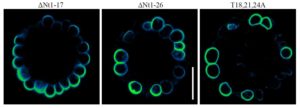 NIP5;1 contains three copies of a a distinctive Thr-Pro-Gly (TPG) repeat in its N terminus that is not found in closely related proteins that do not show polar localization. Deletion of 17 N-terminal residues (up to, but not including, the TPG repeat) had little effect on polar localization of GFP-NIP5;1, which displayed a wild-type localization pattern in root cells, being found primarily on the soil-facing side of cells (see figure, left panel). However, deletion of an additional nine residues (containing the triple TPG repeat) nearly eliminated polar localization (see figure, middle panel).
NIP5;1 contains three copies of a a distinctive Thr-Pro-Gly (TPG) repeat in its N terminus that is not found in closely related proteins that do not show polar localization. Deletion of 17 N-terminal residues (up to, but not including, the TPG repeat) had little effect on polar localization of GFP-NIP5;1, which displayed a wild-type localization pattern in root cells, being found primarily on the soil-facing side of cells (see figure, left panel). However, deletion of an additional nine residues (containing the triple TPG repeat) nearly eliminated polar localization (see figure, middle panel).
Whereas replacement of the three Thr residues in the TPG repeat with the phosphomimic Asp (T18,21,24D) had little effect on polar localization, replacement with nonphosphorylatable Ala residues (T18,21,24A) eliminated normal polar localization (see figure, right panel). In addition, the T18,21,24A mutant sequence was unable to complement the growth defect of nip5;1 in boron-limited conditions. This was not due to a defect in transport activity, as it was shown that the T18,21,24A mutant protein expressed in Xenopus laevis oocytes had wild-type boric acid transport activity.
Treatment with brefeldin A, which inhibits recycling of internalized plasma membrane proteins, caused formation of aggregates containing GFP-NIP5;1, but none were seen with the T18A.T21A.T24A mutant, suggesting that threonine phosphorylation in the TPG repeat accelerated the endocytosis of NIP5;1. In addition, polar localization was greatly diminished in ap2m mutants, which are deficient in adaptor protein 2, a core component required for clathrin-mediated endocytosis.
In summary, Wang et al. have shown that proper polar localization of the boric acid transporter NIP5;1 is maintained by threonine phosphorylation in the N-terminal TPG repeat and that proper localization mediated by clathrin-dependent endocytosis is necessary for proper growth of plants under boron-limited conditions. It will be interesting not only to further analyze the mechanism of polar localization of NIP5;1 but also to discover whether the NIP5;1 N-terminal TPG domain can function in chimeric proteins to direct the polar localization of other membrane proteins.
REFERENCES
Feraru, E., Feraru, M.I., Kleine-Vehn, J., Martinière, A., Mouille, G., Vanneste, S., Vernhettes, S., Runions, J., and Friml, J. (2011). PIN polarity maintenance by the cell wall in Arabidopsis. Curr. Biol. 21: 338–343.
Łangowski, Ł., Wabnik, K., Li, H., Vanneste, S., Naramoto, S., Tanaka, H., and Friml, J. (2016). Cellular mechanisms for cargo delivery and polarity maintenance at different polar domains in plant cells. Cell Discov. 2: 16018.
Takano, J., Wada, M., Ludewig, U., Schaaf, G., von Wirén, N., and Fujiwara, T. (2006). The Arabidopsis major intrinsic protein NIP5;1 is essential for efficient boron uptake and plant development under boron limitation. Plant Cell 18: 1498–1509.
Wang, S., Yoshinari, A., Shimada, T., Hara-Nishimura, I., Mitani-Ueno, N., Ma, J. F., Naito, S., and Takano, J. (2017) Polar Localization of the NIP5;1 Boric Acid Channel is Maintained by Endocytosis and Facilitates Boron Transport in Arabidopsis Roots. Plant Cell 10.1105/tpc.16.00825.
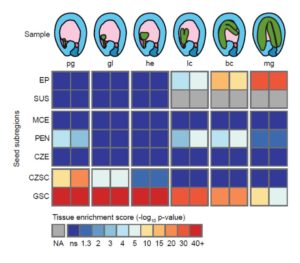 Knowing where a gene is expressed provides valuable information about its function, but that information is compromised if the RNA source is contaminated by other tissues. Schon and Nodine investigated the extent to which Arabidopsis embryo and endosperm transcriptome datasets are affected by tissue contamination. Using seed coat-specific RNAs as markers of maternal tissues and also parent-of-origin small nucleotide polymorphisms (SNPs), the authors found evidence of widespread contamination by maternal tissues, particularly for those datasets representing earlier (smaller) embryos. This finding has implications for interpretations of imprinting (parent-of-origin specific gene expression) in embryos. The authors propose best practices for tissue dissection and also have developed a tool to quantify the extent of contamination of a sample. Plant Cell 10.1105/tpc.16.00845
Knowing where a gene is expressed provides valuable information about its function, but that information is compromised if the RNA source is contaminated by other tissues. Schon and Nodine investigated the extent to which Arabidopsis embryo and endosperm transcriptome datasets are affected by tissue contamination. Using seed coat-specific RNAs as markers of maternal tissues and also parent-of-origin small nucleotide polymorphisms (SNPs), the authors found evidence of widespread contamination by maternal tissues, particularly for those datasets representing earlier (smaller) embryos. This finding has implications for interpretations of imprinting (parent-of-origin specific gene expression) in embryos. The authors propose best practices for tissue dissection and also have developed a tool to quantify the extent of contamination of a sample. Plant Cell 10.1105/tpc.16.00845

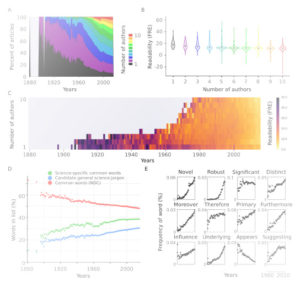 “Reporting science clearly and accurately is a fundamental part of the scientific process, facilitating both the dissemination of knowledge and reproducibility of results.” In this way, Plavén-Sigray et al. introduce us to their preprint in which they analyzed readability in over 700,000 abstracts of scientific articles published in 122 biomedical journals from 1881-2015. Using two different metrics that account for complexity of words and sentences, they found that readability of scientific papers is decreasing steadily over time. This decline is positively correlated with complexity of the rest of the manuscript, showing this trend exceeds abstracts and reflects the whole texts. Moreover, complexity over time is also associated with increasing number of co-authors (although that doesn’t fully explain the trend) and use of in-group science-specific words (jargon). Decreasing readability is a problem when science needs to be explained to non-specialists (digested facts and scientific results can be misinterpreted). This problem even affects specialists, as previously the number of citations has been negatively associated with increasing complexity of language use in papers. So, are we making science less accessible even for ourselves, scientists? (Summary by
“Reporting science clearly and accurately is a fundamental part of the scientific process, facilitating both the dissemination of knowledge and reproducibility of results.” In this way, Plavén-Sigray et al. introduce us to their preprint in which they analyzed readability in over 700,000 abstracts of scientific articles published in 122 biomedical journals from 1881-2015. Using two different metrics that account for complexity of words and sentences, they found that readability of scientific papers is decreasing steadily over time. This decline is positively correlated with complexity of the rest of the manuscript, showing this trend exceeds abstracts and reflects the whole texts. Moreover, complexity over time is also associated with increasing number of co-authors (although that doesn’t fully explain the trend) and use of in-group science-specific words (jargon). Decreasing readability is a problem when science needs to be explained to non-specialists (digested facts and scientific results can be misinterpreted). This problem even affects specialists, as previously the number of citations has been negatively associated with increasing complexity of language use in papers. So, are we making science less accessible even for ourselves, scientists? (Summary by  A model is only as good as the data that go into it (garbage in, garbage out), so any effort to improve remote sensing data will contribute to better global models. Badgley et al. describe a new parameter, near-infrared reflectance of vegetation (NIRV), that more accurately quantifies photosynthesis at the global scale (Gross Primary Productivity, GPP) from satellite sensor data. NIRV combines total near-infrared reflectance (NIRT) and the normalized difference vegetation index (NDVI), so therefore “NIRV represents the proportion of pixel reflectance attributable to the vegetation in the pixel.” The authors show that NIRV shows a closer correlation to GPP than solar-induced chlorophyll fluorescence (SIF). Science Adv.
A model is only as good as the data that go into it (garbage in, garbage out), so any effort to improve remote sensing data will contribute to better global models. Badgley et al. describe a new parameter, near-infrared reflectance of vegetation (NIRV), that more accurately quantifies photosynthesis at the global scale (Gross Primary Productivity, GPP) from satellite sensor data. NIRV combines total near-infrared reflectance (NIRT) and the normalized difference vegetation index (NDVI), so therefore “NIRV represents the proportion of pixel reflectance attributable to the vegetation in the pixel.” The authors show that NIRV shows a closer correlation to GPP than solar-induced chlorophyll fluorescence (SIF). Science Adv. 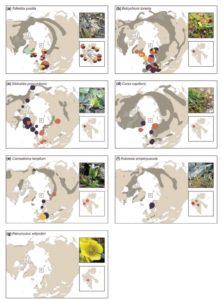 The Arctic provides numerous opportunities to study how climate change and isolation affect plant populations. Birkeland et al. queried the genetic diversity within isolated populations of seven heat-loving (thermophilous) species in the high Arctic (74° – 81° N) Svalbard Archipelago, near the well-known seedbank. These thermophilous plants are thought to be relicts from early Holocene warm periods (9000 – 5000 years ago). The populations studied show low genetic diversity, probably due to founder or bottleneck effects and limited gene flow. This low genetic diversity may limit the ability of these rare plants to benefit from ongoing Arctic warming. AoB Plants
The Arctic provides numerous opportunities to study how climate change and isolation affect plant populations. Birkeland et al. queried the genetic diversity within isolated populations of seven heat-loving (thermophilous) species in the high Arctic (74° – 81° N) Svalbard Archipelago, near the well-known seedbank. These thermophilous plants are thought to be relicts from early Holocene warm periods (9000 – 5000 years ago). The populations studied show low genetic diversity, probably due to founder or bottleneck effects and limited gene flow. This low genetic diversity may limit the ability of these rare plants to benefit from ongoing Arctic warming. AoB Plants 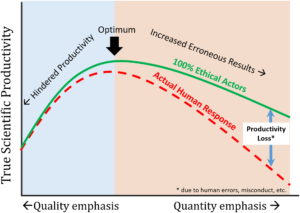 In recent years it has become clear that misconduct in the scientific community is pervasive. In this recent publication by Edwards et al., the authors investigate the potential causes of this problem. Their conclusion is that due to decreased research funding from governments, development of quantitative metrics for research output, and a changing business model for higher education, a climate of hypercompetition is created. As a result, to survive in the modern science community, more and more scientist compromise on their scientific integrity to stay ahead of the competition. (Summary by
In recent years it has become clear that misconduct in the scientific community is pervasive. In this recent publication by Edwards et al., the authors investigate the potential causes of this problem. Their conclusion is that due to decreased research funding from governments, development of quantitative metrics for research output, and a changing business model for higher education, a climate of hypercompetition is created. As a result, to survive in the modern science community, more and more scientist compromise on their scientific integrity to stay ahead of the competition. (Summary by  Roughly 66 million years ago Earth was hit by a huge asteroid, resulting in climate changes that led to mass extinctions, most famously of the non-avian dinosaurs. This catastrophic event, which marks the boundary between the Cretaceous (K) and Paleogene (Pg) periods, also caused widespread mass extinctions in the plant kingdom. Previously, it has been noted that many whole-genome duplications in plants trace to the K/Pg boundary, and a popular selectionist theory is that polyploidization conferred an adaptive advantage under these challenging conditions. Freeling offers an alternative, mutationist hypothesis, that these polyploidizations survived as a byproduct (spandrel) of selection for asexuality: survival of a mass extinction may have depended first on asexuality, and having survived, a polyploid background might then provide an environment of relaxed selection pressure that would support experimentation and absorb massive failure. He concludes by observing the need for a greater understanding of the genetics of asexuality in plants. Plant Cell
Roughly 66 million years ago Earth was hit by a huge asteroid, resulting in climate changes that led to mass extinctions, most famously of the non-avian dinosaurs. This catastrophic event, which marks the boundary between the Cretaceous (K) and Paleogene (Pg) periods, also caused widespread mass extinctions in the plant kingdom. Previously, it has been noted that many whole-genome duplications in plants trace to the K/Pg boundary, and a popular selectionist theory is that polyploidization conferred an adaptive advantage under these challenging conditions. Freeling offers an alternative, mutationist hypothesis, that these polyploidizations survived as a byproduct (spandrel) of selection for asexuality: survival of a mass extinction may have depended first on asexuality, and having survived, a polyploid background might then provide an environment of relaxed selection pressure that would support experimentation and absorb massive failure. He concludes by observing the need for a greater understanding of the genetics of asexuality in plants. Plant Cell  Speciation events result from a combination of molecular, environmental and stochastic (random) factors. Several models developed in the last 150 years help to explain how species emerge, but more recently evolutionary developmental biology (evo-devo) approaches give us tools to decipher plant speciation. In this review, Fernández-Mazueco and Glover show us the available evidence, from macro- to micro-evolutionary scales, of why plants are excellent study systems of speciation. They discuss how an integrative study of intra- and inter-specific variation in polyploidy, morphology, phenotypic plasticity, epigenetic inheritance, etc., could shed light in evolution of new species. This is a nice piece of literature for discussing with students! (Summary by
Speciation events result from a combination of molecular, environmental and stochastic (random) factors. Several models developed in the last 150 years help to explain how species emerge, but more recently evolutionary developmental biology (evo-devo) approaches give us tools to decipher plant speciation. In this review, Fernández-Mazueco and Glover show us the available evidence, from macro- to micro-evolutionary scales, of why plants are excellent study systems of speciation. They discuss how an integrative study of intra- and inter-specific variation in polyploidy, morphology, phenotypic plasticity, epigenetic inheritance, etc., could shed light in evolution of new species. This is a nice piece of literature for discussing with students! (Summary by  “The benefits of organic agriculture are widely debated. Although some promote it as a solution to our sustainable food security challenges, others condemn it as a backward and romanticized version of agriculture that would lead to hunger and environmental devastation.” Seufert and Ramankutty address these conflicting views through a systematic analysis of organic agriculture’s potential benefits and environmental performance (as affected by lower yields). This is an accessible and information-rich review particularly useful for students. Science Adv.
“The benefits of organic agriculture are widely debated. Although some promote it as a solution to our sustainable food security challenges, others condemn it as a backward and romanticized version of agriculture that would lead to hunger and environmental devastation.” Seufert and Ramankutty address these conflicting views through a systematic analysis of organic agriculture’s potential benefits and environmental performance (as affected by lower yields). This is an accessible and information-rich review particularly useful for students. Science Adv.  NIP5;1 contains three copies of a a distinctive Thr-Pro-Gly (TPG) repeat in its N terminus that is not found in closely related proteins that do not show polar localization. Deletion of 17 N-terminal residues (up to, but not including, the TPG repeat) had little effect on polar localization of GFP-NIP5;1, which displayed a wild-type localization pattern in root cells, being found primarily on the soil-facing side of cells (see figure, left panel). However, deletion of an additional nine residues (containing the triple TPG repeat) nearly eliminated polar localization (see figure, middle panel).
NIP5;1 contains three copies of a a distinctive Thr-Pro-Gly (TPG) repeat in its N terminus that is not found in closely related proteins that do not show polar localization. Deletion of 17 N-terminal residues (up to, but not including, the TPG repeat) had little effect on polar localization of GFP-NIP5;1, which displayed a wild-type localization pattern in root cells, being found primarily on the soil-facing side of cells (see figure, left panel). However, deletion of an additional nine residues (containing the triple TPG repeat) nearly eliminated polar localization (see figure, middle panel).